![]()
![]()
![]()
Use LEFT and RIGHT arrow keys to navigate between flashcards;
Use UP and DOWN arrow keys to flip the card;
H to show hint;
A reads text to speech;
115 Cards in this Set
- Front
- Back
|
Phospholipid
|
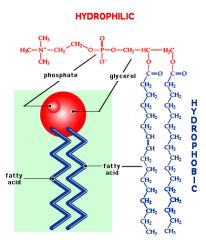
|
|
|
What is charged and what is not? Hydrophilic and hydrophobic
|
Hydrophilic is polar and charged while hydrophobic is non-polar and not charged.
|
|
|
A majority of phospholipids are unsaturated and it kinds their tails, what does this do?
|
Increases the space between them and increases membrane fluidity.
|
|
|
Glycolipids
|
Lipids with attached sugar groups, found only on the outer plasma membrane. Sugar groups are polar, while tails remain nonpolar.
|
|
|
Lipid Rafts
|
Dynamic assemblies o fsaturated phopholipids associtaed with unique lipids called sphingolipids. Can include or exclude specific proteins. Used for receptor molecules or for molecules needed in cell signaling.
|
|
|
Proteins make up half the plasma membrane by mass and are responsible for specialized functions. What are the two distinct populations of membrane proteins?
|
Integral proteins and peripheral proteins.
|
|
|
Integral proteins
|
Most are transmembrane proteins that span the whole membrane. Have hydrophobic/phylic regions. Some form channels/pores through which small water soluble molecules or ions can move. others act as carriers that bind a substance and move it through the membrane. Others are recepeors for hormones or other chemical messangers. and relay messages t the cell interior (signal transduction)
|
|
|
Peripheral proteins
|
Not imbedded in the membrane but can be easily removed with out disrupting the membrane. Include filaments that support the membrane from the cytoplasm. Some are ezymes, others are motor proteins involved in mechanical functions such as muscle cell contractions, others link cells together, some float freely while most are tethered to the cytoskeleton.
|
|
|
Glycocalyx
|
Fuzzy, sticky, carbodydrate rich area at the cell suface. Provides biological markers at the surface.
|
|
|
CAM proteins
|
Intercellular junctions, that provide temporary binding sites that guide cell migration and other cell-to-cell interactions.
|
|
|
What two types of membrane juctions would you expect to find between muscle cells of the heart?
|
Desmosomes (anchoring junctions) to secure cardiac cells together as the heart works and gap junctions (communicating junctions) that allow ions to flow from cell to cell.
|
|
|
Desmosomes
|
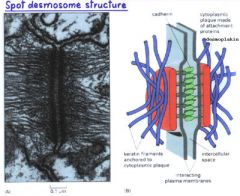
Anchoring junctions.
|
|
|
Tight Junction
|
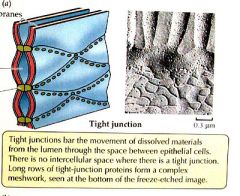
Impermeable junction
|
|
|
Gap Junctions
|
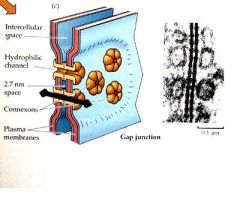
|
|
|
What is the energy source for all types of diffusion?
|
Diffusion is driven by the kinetic energy of the molecules.
|
|
|
What determines the direction of any diffusion process?
|
the relative concentration of the substance in different areas determines the directio of diffusion. diffusion occurs from high to low.
|
|
|
What are the two types of facilitated diffusion and how do they differ?
|
Channel and carrier mediated diffusion.
In channel mediated diffusion the diffusing substances moves through a membrane channel. In carrier mediated diffusion, the diffusing substance attaches to a membran (protein) carrier which moves it across teh membrane. |
|
|
Where is the extracellular fluid called intersitial fluid derived from?
|
The blood. It is a rich soup that includes amino acids, sugars, fatty acids, vitamins, regulatory hormones and neurotransmitters, salts and waste products. Cell must extract what it needs from this mix.
|
|
|
What two ways to substances move across membranes?
|
Passive = no energy to happen.
Active = requires energy (ATP) |
|
|
Facilitated transport
|
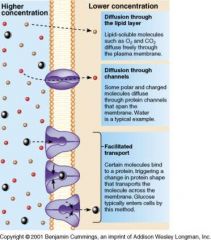
|
|
|
Channels
|
Transmembrane proteins transport ions or water through aqueous channes. Selective due to pore size, and the charges of AA lining the channel. Leakage channels stay open and allow ion and water to flux according to diffusion gradiant.
|
|
|
What is more controllable, simple diffusion or facilitated diffusion?
|
Facilitated diffusion because it is easier to control the membrane proteins than the membrane itself.
|
|
|
Osmosis
|
Diffusion of a solvent such as water through a selectively permeable membrane. Water is highly polar but is passes via osmosis through the lipid bilayer.
|
|
|
Aquaporins (AQP)
|
Water moves freely both ways through these water specific channels. Abundant in RBC's and kidney tubule cells.
|
|
|
Is it the type or number of solute paritcles that matters in osmosis?
|
The number because one molecule or one ion of solute displaces one water molecule.
|
|
|
Osmolarity
|
Total concentration of all solute particles in a solution.
|
|
|
Hydrostatic Pressure
|
Back pressure exerted by water against the membrane. Offsets osmotic pressure when water diffusing into the cell.
|
|
|
Osmotic pressure
|
Tendency of water to move into the cell by osmosis.
|
|
|
Why doesn't hydrostatic pressure get very high in animal cells?
|
Plasma membrane is flexible and will break.
|
|
|
Tonicity
|
the ability of a solution to change the shape or tone of cells by altering their internal water volume is called tonicity.
|
|
|
Isotonic
|
Same tonicity. 0.9 saline or D5W.
|
|
|
Hypertonic solutions will what to a cell?
|
Crenate or shrink it.
|
|
|
What will distilled water do to a cell?
|
It will lyse or burt it.
|
|
|
Compare tonicity and osmolarity.
|
Osmolarity is based solely on its total solute concentration. In contrast, its tonicity is basedon how the solution affects cell volume, which depends on solute conentration and solute permeability of the plasma membrane.
|
|
|
Units of osmolarity
|
osmol/L where 1 osmol is equal to 1 mole of nonionizing molecules.
|
|
|
Why is a penetrating solute dangerous to a cell?
|
It will penetrate the cell and bring water with it and burst the cell.
|
|
|
In the capillaries...
|
Hyrdostatic pressure pushes the water out, but large solutes pulls it back in again later.
|
|
|
What is more selective, simple or facilitated diffusion?
|
Facilitated diffusion.
|
|
|
What is the energy source for simple diffusion, facilitated diffusion and osmosis?
|
Kinetic energy.
|
|
|
Primary active Transport
|
ATP hydrolysis
Against concentration or electrochemical gradient. Across membrane by solute pump. Ions (Na, K, Ca and others) |
|
|
Secondary active transport
|
ATP maintained concentration gradient.
Cotransport. energy supplied indirectly by ion gradient created by primary active transport. SYMPORTERS move substances in same direction; ANTIPORTERS move substances in opposite directions. Movement of polar or charged solutes: AA (symporter into cell) Ca, H (out of cell by antiporter) |
|
|
Ratio of Na to K transport
|
3 Na for 2K
|
|
|
Carrier enzyme for Na K pump
|
Na K ATPase
|
|
|
Vesicular transport (requires ATP or in some cases GTP)
|
Exocytosis
Endocytosis Intracellular vesicular trafficking. |
|
|
Exocytosis
|
Interior to exterior
|
|
|
Endocytosis
|
Exterior to interior.
|
|
|
Transcytosis
|
Into, across and then out of the cell.
|
|
|
Vesicular trafficking
|
moving substances from one area or organelle in the cell to another.
|
|
|
Clathrin
|
Protein found on the infolding portion of the plasma membrane in endocytosis.
|
|
|
Endosome
|
sorting vesicle
|
|
|
Pinocytosis-fluid phase endocytosis or cell drinking.
|
Nonselective way of an infolding palasma membrane to wurround small volume of fluid. Fuses with an endosome. Unlike phagocytosis, pinocytosis is a routine function.
|
|
|
Receptor mediated endocytosis.
|
Very selective endocytosis and transcytosis. External substance binds to membrane receptors. Intake of some hormones (insulin), cholesterol and iron. Diptheria and chlolera attach via this method.
|
|
|
Potosis
|
Specific to molecules using Caveolae "little caves". Smaller than the clathrin coated vesicles and use a different protein called aveolin.
|
|
|
What are Caveolae associated with?
|
Lipid rafts that are platofrms for G proteins. Involved in some form of cell signalling.
|
|
|
Intracellular vesicular trafficking
|
ATP is used. via coatomer coated vesicles. Vesicles pinch off from organelles and travel to other organelles almost all traffic between ER and Golgi.
|
|
|
Exocytosis with v-SNARE and t-SNARE proteins.
|
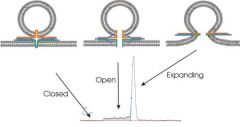
|
|
|
What happens when the Na-K pump is phosphorylated? When K binds to the pump protein?
|
Phosphorylation of the Na-K pump causes the pump protein to change shape and pump Na across the membrane. K binding to the pump protein triggers the release of phosphate and the pump returns to its original shape.
|
|
|
As a cell grows, its plasma membrane expands. Does this membrane expansion involve endocytosis or exocytosis?
|
The plasma membrane expands as a result of exocytosis.
|
|
|
Phagocytic cells gather in the lungs, particularly in the lungs of smokers. What is the connection?
|
Phagocytic cells engulf debris and a smoker's lungs would be laden with caron particles and other debris from smoke inhalation.
|
|
|
What vesicular transport process allows a cell to take in cholesterol from the extracellular fluid?
|
Cholesterol is taken in by receptor mediated endocytosis.
|
|
|
Membrane potential.
|
Voltage across a membrane.
|
|
|
Voltage
|
electrical PE resulting rom the separation of oppositely charged particles. In cells th ethe oppositel charged particles are ions and the barier that keeps them apart is the plasma membrane.
|
|
|
What does the negative sign mean in the resting membrane potential -70mV?
|
It means the inside fo the cell is negative compared to the outside. This voltage (or charge separation) exists only at the membrane. Total charge across the cell is neutral.
|
|
|
Polarized
|
State of plasma membrane of an unstimulated neuron or muscle cell in which the inside of the cell is relatively negative when compared to the outside.
|
|
|
What ion mainly determines RMP?
|
Gradient and differential permeability of K.
|
|
|
Membrane is more permeable to Na or K?
|
K.
|
|
|
What is the cell RMP voltage?
|
-70 mV.
|
|
|
Without active transport what is the net flow of Na and K?
|
K out and Na in.
|
|
|
What event or process established the resting membrane potential?
|
diffusion of ions, mainly K from the cell through leakage channels, established the RMP.
|
|
|
The inside of the polarized plasma membrane is negative or positive relative to the outside?
|
Negative
|
|
|
Cell adhesion molecules (CAM) found on every cell. These sticky glycoprotis (cadherins and intergrins) act as:
|
1] molecular velcro.
2]arms to haul themselves past one another. 3]SOS signals 4]Mechanical sensors of tension and stimulate sytnehsis or degradation of adhesive membrane junctions. 5] transmitters of intracellular signals that direct cell migrationn, proliferation and specialization. |
|
|
Membrane receptors: integral proteins and glycoproteins that serve as binding sites. Their functions are:
|
CONTACT SIGNALING: touching for recognition.
CHEMICAL SIGNALING:use ligands on membrane receptors ie neurotransmitters. G-protein-linked receptors. |
|
|
What is a common similarity to ligand binding when reactions to the binding is so different in various cell?
|
When a ligan binds to a membrane receptor, the receptors structure changes and cell proeins are altered in some way.
|
|
|
G-linked protein receptors
|
Exert their effect indirectly throug a G protein with is a middleman to acitvation. Promotes formation of second messengers.
|
|
|
What term is used to indicate signaling chemicals that bind to membrane receptors? Which type of membrane receptor is most important in driecting intracellular events by prmoting formation of second messengers?
|
Ligands. g protein linked receptros direc intracelluar events by promoting formation of second messengers.
|
|
|
where might you commonly find voltage gated channels?
|
Neural and muscle tissues.
|
|
|
What is the sequence of events in a G protein?
|
Ligand (1st messanger)
receptor G protein Enzyme 2nd messanger (cAMP, iCa) |
|
|
Cytosol
|
Vscous semitrasparent fluid in which th eother cytoplamic elements are suspended.
|
|
|
Cytoplasmic organelles
|
metabolic machiner of the cell. Each type carries out a specific function.
|
|
|
Inclusions
|
Chemical substance stham may or may not be present, depending on cell type. Glycogen granules in liver and muscle cells.
|
|
|
Nonmembranous organelles
|
Lack membranes such as cytoskeleton, centrioles and ribosomes.
|
|
|
Mitochondria
|
Twomembranes. Outer and inner. Inner has shelflike cristae. Performs cellular respiration to attach phosphate to ADP molecule have their own DNA, RNA and ribosomes and can reproduce themselves.
|
|
|
Ribosomes
|
Has two globular subunts that fit together like a body and cap of acorn. Site of protein synthesis. Ribosomal RNA.
|
|
|
What are the two populations of ribosomes?
|
Float free in cytoplasm
Attached to membranes forming rough endoplamic reticulum. |
|
|
How do the two populations of ribosomes split protein sythesis?
|
Fee: soluble proteins that function in the cytosols as well as those for mitochondria and other organelles.
Membrane: sythesize proteins for incorporation into cell membranes of for export from the cell. |
|
|
Can ribosomes switch back between free and bound?
|
Yes depending on the protein they are making.
|
|
|
Endosplasmic Reticulum
|
Continuous with the nuclear membrane and accounts for half of the cell's membrane. Sytem of interconnected tubes and parallel membranes enclosing fluid filled cisternae. Two varieties rough and smooth ER.
|
|
|
Rough ER
|
Makes proteins that are coated in coatomer coated vesicles for journey to Golgi. teh membrane factory
|
|
|
Smooth ER
|
Not involved in protein sythesis intstead:
Lipid metabolism, cholesterol sythesis,.. Synthesis of steroid based hromones Absorption , synthesis of ffats Detox of drugs Breakdown of glycogen to form free glucose. |
|
|
What is the smooth ER called in muscle cells?
|
Sarcoplasmic reticulum an it plays a role in clacium ion storage and release during muscle contraction.
|
|
|
What organelle is the major site of ATP synthesis?
|
Mitochondria
|
|
|
What are three organelles involved in protein synthesis and how do these organelles interact in that process?
|
Ribosomes are the sites of protein synthesis. Roug ER proides a site for ribosome attachment and its cisternae package in vesicles the proteins made on the ribosomes for transort to the Golgi apparatus. Golgi modifies and packages the prorteins it receive for various destinatoins in or out of the cell.
|
|
|
How does the function of lysosomes compar to that of peroxisomes?
|
Lysosomes digest foreign substances, deteriorating organelles or even the cell to prevent buildup of cellular debris. Peroxisomes detox harmful chemicals and neutralize free radicals.
|
|
|
How are Microtubules and microfilaments related functionally?
|
Both are involved in organelle movements within the cell and or movements of the cell as a whole.
|
|
|
Of microfilaments, microtubules, or intermediate filaments, which is most importan in maintianing cell shape?
|
Intermediate filaments are most important in cell shape.
|
|
|
The major function of cilia is to move substances across the free cell surface. What is the major role of microvilli?
|
Microvilli increase the cell's surface area ofr absorption or filtration.
|
|
|
If a cell ejects or loses its nucleus, what is its fate and why?
|
It will die because it will be unable to make proteins, and enzymes needed for reactions.
|
|
|
What is the role of nucleoli?
|
site of ribosome subunit manufacture.
|
|
|
What is the importance of the histone proteins present in the nucleus?
|
Allow DNA to be packed i a compact orderly way and play a role in gene regulation.
|
|
|
If one of the strands of DA being replicated reads CGAATG, what will be the base sequenc of the corresponding DNA strand?
|
GCTTAC
|
|
|
During what phase of the cell cycle is DNA synthesized
|
During the S phase
|
|
|
29] Codons and anitcodons are both three base sequences. How do they differ?
|
Codons are three base sequences in mRNA each of which specifies an amino acid. Anticodons are three base sequences in tRNA that are complementary to the codons specifiying the amino acid they transport to the ribosome during protein sythesis.
|
|
|
30] How do the A, P, and E ribosomal sites differ functionally during protein synthesis?
|
A site = entry site for tRNA at the ribosome.
P site = site where peptide bonds form between delivered amino acids. E site = the tRNA exit site from the ribosome. |
|
|
31] What is the role of DNA in transcription?
|
DNA provides the coded instructions (the template) for protein synthesis via mRNA synthesized on it.
|
|
|
32] What is importance of ubiquitin in the life of a cell?
|
Ubiquitin attaches to misfolded, damaged, or unneeded proteins, tagging them for destruction by proteasomes.
|
|
|
33] What are two body fluids that inhabit the extracellular space and what role does each play in the body?
|
Blood plasma is extracellular flulid that transports nutrients, gases, hormones, and other substanaces throughout the body.
Interstitial fluid is an important transport and dissolving medium. |
|
|
34] What is apoptosis and what is its importance in the body?
|
Apoptosis is aprocess of programmed cell death which rids the body of cells that are stressed, damaged, old, or no longer needed.
|
|
|
35] What is the wear and tear theory of aging?
|
the wear and tear theory of Tging attributes aging to little chemical insults and free radicals which have cumulative detrimental effects.
|
|
|
ANAPLASIA
|
Abnomalities in cell structure and loss of differentiation; for example, cancer cells typically lose the appearance of parent cells and come to rsemble undifferenctiated or embryonic cells.
|
|
|
DYSPLASIA
|
A change in cell size, shape, or arrangement due to chronic irritation or inflammation (infections, etc.)
|
|
|
HYPERTROPHY
|
Growth of an organ or tissue due to an increase in the size of its cells. hpertrophy is a normal response of skeletal muscle cells when they are challenged to lift excessive weight; differes from hyperplasia, which is an increase in size due to an increase in cell number.
|
|
|
LIPOSOMES
|
Hollow microscopic sacs formed of phospholipids that can be filled with a variety of drugs. Serve as multipurpose vehicles for drugs, genetic material, and cosmetics.
|
|
|
MUTATION
|
A change in DNA base sequence that may lead to incorporation of incorrect amino acids in particular positions in the resulting protein; the affected protein may remain unimpaired or many function abnormally or not at all, leading to disease.
|
|
|
NECROSIS
|
Death of a cell or group of cells due to injury of disase. Acute injury causes the cells to swell and burst, and induces the inflammatory response. (This is uncontrolled cell death, in contrast to apoptosis or planned cell death).
|
|
|
Golgi Apparatus
|
Looks like hollow dinner plates stacked.
MAJOR FUNCTION: modify, concentrate, and package proteins and lipids made in the rough ER. Cis face (convex receiving side) trans face (concave shipping side) also packages enzymes into memgranous lysosomes that remain in the cell. |

